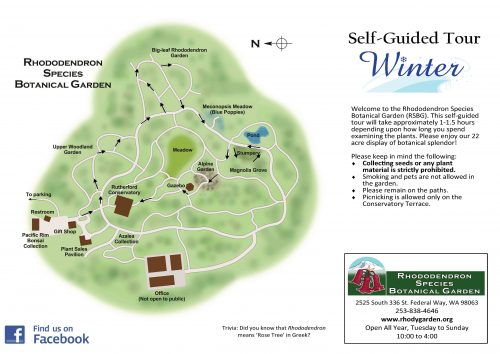From the Garden Shop, walk straight to visit #1 Betula jacquemontii to your left. The Himalayan White Birch is native to Kashmir in the western Himalayas and is known for its distinct, bright white bark and resistance to all of the problems that plague most other white birches in cultivation.
Take a left on the main road and follow the sign to visit the Upper Woodland Garden, which features many rhododendrons with thickly indumented leaf undersurfaces. For example, walk towards #2 Rhododendron bureavii and look at the underside of the leaves. You will see the beautiful orange-brown indumentum, which serves to protect the plants from cold and heat, store water, and repel insects among other things. R. bureavii is one of the most superb foliage plants in the genus.
A little further on, you will see #3 Luzula sylvatica (Golden Wood Rush) on your right. The evergreen grass-like leaves of this plant are gold-green in the spring, maturing to lime green at the end of the season adding wonderful color to a shady part of the garden. Keep going until you see #4 Speirantha convallarioides (False Lily of the Valley), on your left. This is a choice, very slow-growing evergreen groundcover with fragrant flowers in spring. Nearby is #5 Coptis laciniata, (Gold Thread). This slow-spreading groundcover is native to the Pacific Northwest. The name comes from the golden yellow rhizomes that creep just beneath the surface of the ground.
Follow the sign to the main path and make a left turn. Pass the bamboo on your right and follow the sign to the narrow path to your left. This area is called the Big Leaf Garden. Most of the big-leafed rhododendrons eventually become very large trees in their native temperate rainforests in the Sino-Himalayas. Stay on the path to the left to visit #6 Rhododendron falconeri* on your left. Their magnificent large leaves are among the most attractive of the big-leaf species. As they get older, their bark will turn reddish brown. Veer slightly to the right and follow the sign to #7 Matteuccia struthiopteris (Ostrich Fern). You will notice the vegetative fronds have fallen over but the fertile fronds are still standing up. Rub your hands against the standing fertile fronds and you can observe the spores coming off. Follow the sign to the plantings of #8 Rhododendron rex* on both sides. This plant has extremely attractive, shiny deep-green foliage with a thick gray to buff indumentum beneath. In China, where it grows wild, it can attain heights of up to 45 feet. R. rex is one of the hardiest and most attractive of the big-leafed rhododendrons in our climate. Notice there are two sizes of buds. Rhododendron buds set a year before they flower, usually during the summer season. The flowers buds are significantly larger than the vegetative buds, as you can see on R. rex.
Now, make a left turn on the main path. Pass the Himalayan Blue Poppy Meadow on your left. The towering stalks hold the seed pods of #9 Cardiocrinum giganteum*, the Himalayan Giant Lily from the Sino-Himalaya. They are monocarpic which means they die after producing flowers. The clumps of fuzzy leaves are the blue poppies which bloom in the spring. Across from the blue poppy meadow, You will see on your right. They have very handsome dark shiny leaves with extremely attractive rusty colored indumentum beneath.
Keep going until you see #11 Acer griseum (Paperbark Maple), on the left corner. This Chinese native features a cinnamon to reddish brown decorative exfoliating bark.
Keep walking to the plantings of #12 Rhododendon exasperatum. Their foliage emerges blue-green and stays smooth and glossy throughout the season. Under R. exasperatum, you will find #13 Gaultheria nummularioides from China. This small scale, evergreen groundcover is spread by above-ground and underground runners. This plant performs well under the rhododendrons forming a dense and attractive mat.
Walk the main path and you will see the Hardy Fern Foundation’s Victorian Stumpery (#14) on your right. A stumpery is an English Victorian period garden design that romanticizes nature. The design uses tree roots and stumps placed on their side or upside down creating a “Wild Scene” which is then planted with thousands of ferns and other woodland plants. Have a seat on the cut cedar-log bench at the top of the Stumpery and enjoy the view of the pond garden.
From the Stumpery, follow the path to the pond garden to visit #15 Rhododendron lanigerum native to Tibet and India. The fuzzy overlapping scales of the flower buds are a very interesting feature at this time of the year. The buds will eventually be the size of a small egg by the time they start to flower in early spring. Walk back to the main path and go back to the paperbark maple and take the first left path.
Go up the hill and you will see #16 Rhododendron pachysanthum* on your left. This is one of the finest foliage plants in the genus Rhododendron. Its indumentum color ranges from silver-white to rich brown on the upper surface, dark orange-brown beneath. It’s native to Taiwan.
Up the hill is the Alpine Garden (#17). Notice almost all the rhododendrons planted in this area have smaller foliage. Most of the plants here are found at high altitudes in the mountains of Asia, mostly in open, sunny conditions. Their smaller foliage limits the amount of water transpiration, which is an adaption better suited for sunny and exposed habitats.
Walk up towards the Gazebo and follow the sign for the self-guided tour which will take you past #18 Stewartia pseudocamellia (Japanese Stewartia), on your left. This is a summer flowering tree with Camellia-like flowers, but in the winter, it features an attrac-tive bark. Continue straight ahead for the Rutherford Conservatory (a separate self-guided handout to tour the Rutherford Conservatory is available inside).
From here, you can walk back to the garden shop where you started. Many of the plants you viewed today are available in the sales area. Most of these plants are rare in retail nurseries. We hope you enjoyed the self-guided tour today. Please come back and visit the garden again soon.
* For sale in the RSBG Nursery and 2016 spring catalog

